Transformational Gardening
June 2009 Garden Experiences
(Back to:
May 2009 Gardening Experiences)
(Forward to:
July 2009 Gardening Experiences)
June 4, 2009
As it turns out, I am very, very allergic to straw and hay. The last week was a foggy-brained,
watery-eyed sneeze-fest! My hope is that when it rains on the straw, it won't bother me so much.
Below are two pictures: 1) "Baldy"; 2) "Baldy with a Straw Hat"
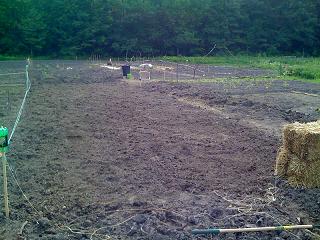
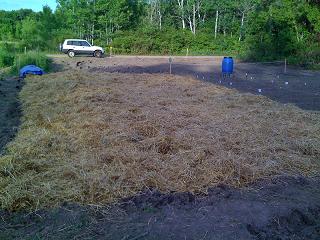
It may seem like the straw is far too thick, but Ruth Stout pointed out that eight inch thick straw
will compress down to two inch thick straw after rains and walking on it. Not enough gardeners were
around to hear my unusual gardening jokes. I wanted to tell my neighboring gardeners that "I could bring
my horses in to graze on the hay and the vegetable tops in other plots."
Now all I have to do is measure out the rows and, according to the
Ruth Stout Method,
rake aside some straw to plant the crops!
June 7, 2009
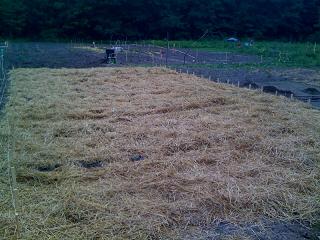 I measured out 18 inches on each edge of the garden for walking (according to community garden rules)
and then staked out 24 rows (two feet apart) and put twine from the stakes across each row. Then it was
off to all of the gardening stores to look for organic seeds and seedlings. Almost everyone else had planted
weeks ago and at this point I had no plan as to what to plant. So, I just started buying whatever organic
seeds and seedlings I could find ... without any rhyme or reason. I kept telling myself and one fellow
gardener that "if I don't get the crops in the ground soon, the city won't have food for the Winter!"
I measured out 18 inches on each edge of the garden for walking (according to community garden rules)
and then staked out 24 rows (two feet apart) and put twine from the stakes across each row. Then it was
off to all of the gardening stores to look for organic seeds and seedlings. Almost everyone else had planted
weeks ago and at this point I had no plan as to what to plant. So, I just started buying whatever organic
seeds and seedlings I could find ... without any rhyme or reason. I kept telling myself and one fellow
gardener that "if I don't get the crops in the ground soon, the city won't have food for the Winter!"
Oh No!!! I made a big mistake. It was nearly impossible to "rake aside" the eight inch thick straw to
plant the rows! And when I could finally push apart the straw to create a row, pushing the straw apart in the
next row tended to close up the first row! The rain had not come and the straw was still very thick even
after walking on it.
So far, I have learned the following:
- Plan the garden in the Winter or Spring so that you can decide what to plant and include some Spring,
Summer and Fall vegetables to have food throughout the season.
- Order seeds early.
- Do not put on eight inches thick of dried straw or hay before planting. Better to put it on a couple
of inches thick before a rain. After the first year, I think the hay and leaf mulch left on throughout the
Winter (to feed and break up the soil) will suffice. After the plants become little seedlings, then add more
mulch.
- Put the straw or hay with stalks parallel to the rows (as much as possible) to make it easy to create
a row.
June 14, 2009
 23 out of 24 rows have been planted!!! Click on the Garden key to the right to see the crops
that have been planted.
23 out of 24 rows have been planted!!! Click on the Garden key to the right to see the crops
that have been planted.
I planted the Radishes (Rudolf & French Breakfast) in Row 23 using the Anastasia Planting Method.
I wanted to do all of the rows that way, but was so involved in my straw allergy attacks that I
forget. Basically, the idea behind the planting method is to grow plants that have healing properties
specific to exactly what your body needs to heal.
Below is an except from “Anastasia” by Vladamir Megre:
“Every seed you plant contains within itself an enormous amount of information about the
Universe. Nothing made by human hands can compare with this information either in size
or accuracy. Through the help of these data the seed knows the exact time, down to the
millisecond, when it is to come alive, grow – what juices it is to take from the Earth, how to
make use of the rays of the celestial bodies – the Sun, Moon and stars, what it is to grow into,
what fruit to bring forth. These fruits are designed to sustain Man’s life.
More powerfully and effectively than any manufactured drugs of the present or future, these fruits
are capable of counteracting and withstanding any disease of the human body. But to this end the
seed must know about the human condition. So that during the maturation process it can satiate its
fruit with the right correlation of substances to heal a specific individual of his disease, if
indeed he has it or is prone to it.
“In order for the seed of a cucumber, tomato or any other plant grown in one’s plot to have
such information, the following steps are necessary:
- “Before planting, put into your mouth one or more little seeds, hold them in your mouth,
under the tongue, for at least nine minutes.
- “Then place the seed between the palms of your hands and hold it there for about thirty seconds.
During this time it is important that you be standing barefoot on the spot of earth where you will later be planting it.
“Open your hands, and carefully raise the seed which you are holding to your mouth. Then blow on it
lightly, warming it with your breath, and the wee little seed will know everything that is within you.
- “Then you need to hold it with your hands open another thirty seconds, presenting the seed to the
celestial bodies. And the seed will determine the moment of its awakening. The planets will all help it! And
will give the sprouts the light they need to produce fruit especially for you.
- “After that you may plant the seed in the ground. In no case should you water it right off, so as not to wash
away the saliva which is now covering it, along with other information about you that the seed will take in.
It can be watered three days after planting.”
There will be more information posted in a separate informational web page about
Anastasia.
The Anastasia Planting Method is pretty straight forward. She recommends that only a few of each
type of plant in the garden be done this way. I did encounter one problem. I tried putting half a
row's worth of seeds in my mouth for nine minutes. When I spit them out into my cupped hands they
overflowed the cupped hands onto the ground. This happened twice even though I was ready for it the
second time. Better to do fewer seeds and remove one-by-one or spit them out into a cup first.
Somehow I expect that the above discussion is not the typical gardening discussion!
June 21, 2009
We have been getting plenty of rain the last week and I think the garden needed it.
About half of the rows are doing well, but many of the rows have tiny sprouts that
do not seem to be getting any bigger (carrots, for example). Hmmm. I wonder why?!
Pictures from the garden:
| Daikon Radish (Row 1) |
Turnips (Row 2) |
Kale (Row 6) |
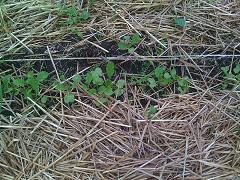 |
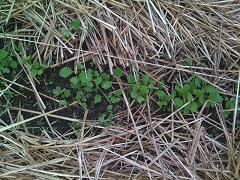 |
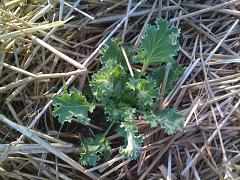 |
| Red Winter Kale (Row 8r) |
Mustard Greens (Row 17) |
Honeydew (Row 21r): Eaten by Insects |
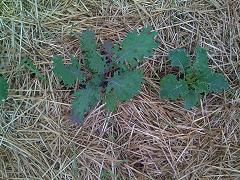 |
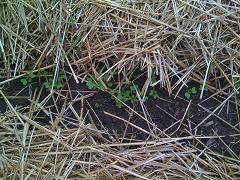 |
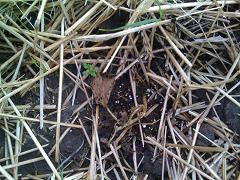 |
| Radish (Rudolf) (Row 23r) |
|
|
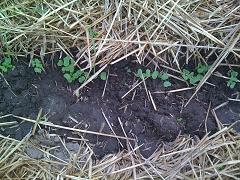
| |
|
Radishes grow amazingly fast, especially daikon and Rudolf. Mustard green are coming up
very fast as well. Watermelon seedlings are not growing much.
June 23, 2009
What is a weed? A plant whose virtues have not yet been discovered."
Ralph Waldo Emerson
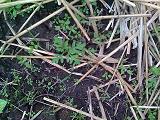 Are they weeds or something I've planted? I have no clue. To the right is a picture of a bunch of things
in Row 4: Carrots. I think the big thing in the center might be a carrot plant, but it may be a weed.
Ruth Stout suggested
few weeds will come up because of the hay/straw and to just throw some hay on top of the weeds that do
come up. But she's making the mistake that her readers (especially me!) know how to tell the difference
between a carrot and a weed!
Are they weeds or something I've planted? I have no clue. To the right is a picture of a bunch of things
in Row 4: Carrots. I think the big thing in the center might be a carrot plant, but it may be a weed.
Ruth Stout suggested
few weeds will come up because of the hay/straw and to just throw some hay on top of the weeds that do
come up. But she's making the mistake that her readers (especially me!) know how to tell the difference
between a carrot and a weed!
 In Row 3: Beets, I think the plant on the right with the purple-tinged leaves might be a beet? But
that big plant to the left looks eerily similar to what I thought was a carrot in the last picture.
Did the carrot wander over to Row 3? Clearly, the carrots, beets and weeds are all conspiring to confuse me!
In Row 3: Beets, I think the plant on the right with the purple-tinged leaves might be a beet? But
that big plant to the left looks eerily similar to what I thought was a carrot in the last picture.
Did the carrot wander over to Row 3? Clearly, the carrots, beets and weeds are all conspiring to confuse me!
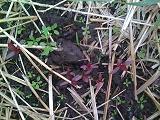 Ah, now this row is a breathe of fresh air. Those burgundy plants on the right side of Row 11 are almost
certainly the Amaranth (Burgundy) that I planted. My discovery: The key to gardening is to not grow any green
plants!
Ah, now this row is a breathe of fresh air. Those burgundy plants on the right side of Row 11 are almost
certainly the Amaranth (Burgundy) that I planted. My discovery: The key to gardening is to not grow any green
plants!
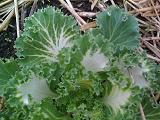 These kale seelings are developing leaves with big white splotches on them. That's interesting!
Maybe the splotches will turn green as the kale matures.
These kale seelings are developing leaves with big white splotches on them. That's interesting!
Maybe the splotches will turn green as the kale matures.
June 26, 2009
I've met many wonderful people at the community garden. Unfortunately, I didn't take the time to
learn their names ... yet. A few days ago I met Shanti and her son who has the garden plot a few
plots to the right of mine and next to the road. Her plot is doing really well and she seems
to have gotten an early start. Today, I met Mary who has a plot near the trees. It has a fence
made of branches and a beehive. She said that they had to get special permission to have the beehive.
Like me, she is also having little success with cucumbers and zuchinni.
Well, things are really hopping and popping upwards in the garden today! What a pleasant surprise!
I worked together with another gardener to identify the carrots in Row 4. I can now tell the
difference between a carrot plant and a weed that looks a little like a carrot plant. There are
some difficulties though. All of the three rows that I planted with Pagano brand seeds (an Italian
company) seem to be doing almost no growing (unless you count weeds). I have to check and see if "Pagano"
in Italian means "dead seed."
The two tables below contain pictures from each row as detailed in the
2009 Garden Key.
The first table are the rows that are doing well. The second table are the one's I'm having some
difficulty with.
Table 1: Rows Doing Well
| Radish (Daikon) (Row 1) |
Turnips (Row 2) |
Beets (Row 3): Not coming up in the whole row. |
Carrots (Row 4): Little, snowflake-like leaves are carrots. Big plants in picture are weeds |
Tomatos Plants (Row 5-r) |
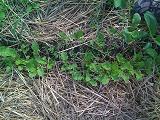 |
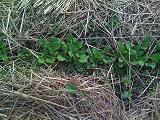 |
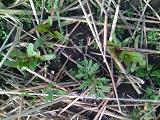 |
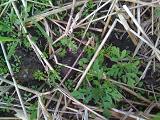 |
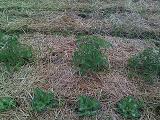 |
| Kale Seedlings (Row 5-l) |
Kale Seedlings (Row 6) |
Kale (Red Winter) (Row 7-l) |
Kale (Red Winter) Seedlings (Row 8-r) |
Cauliflower Seedlings (Row 8-l) |
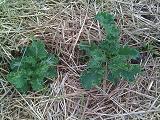 |
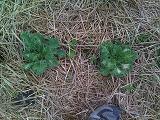 |
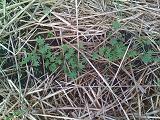 |
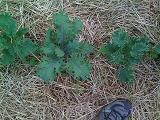 |
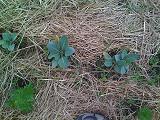 |
| Amaranth (Burgundy) (Row 11-r) |
Mustard Greens (Red Giant) (Row 14-r) |
Coriander/Cilantro (Row 14-l) |
Leaf Lettuce (Black Seeded Simpson) (Row 16) |
Mustard (Southern Giant Curled) (Row 17) |
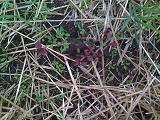 |
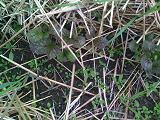 |
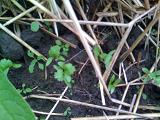 |
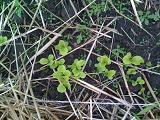 |
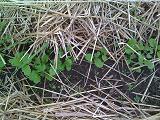 |
| Radish (Rudolf) (Row 23-r |
Radish (French Breakfast) (Row 23-l) |
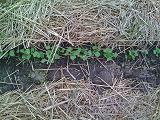 |
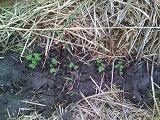 |
Table 2: Rows Doing Poorly
| Kale (Dinosaur) (Row 7-r): Growing very slowly |
Squash (Butternut) Seedlings (Row 9): Not growing |
Squash (Yellow Straight Neck) (Row 10-r): Leaves turning yellow and being eaten |
Parsley (Forest Green) (Row 10-l): Cannot tell if any non-weeds are coming up. |
Parsley (Forest Green) (Row 11-l): Cannot tell if any non-weeds are coming up. |
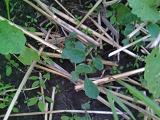 |
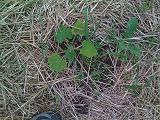 |
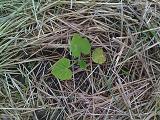 |
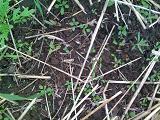 |
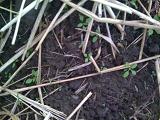 |
| Zuchinni (Row 12): Cannot tell if any non-weeds are coming up. |
Cucumber (Marketmore) (Row 13): Cannot tell if any non-weeds are coming up. |
Parsley (Italian Dark Green Flat) (Row 15): Cannot tell if any non-weeds are coming up. |
Collards (Georgia Green) (Row 18): Growing very slowly. |
Brussels Sprouts (Row 19): Growing very slowly. |
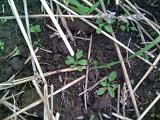 |
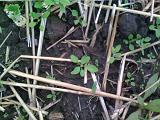 |
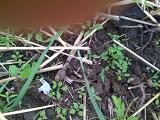 |
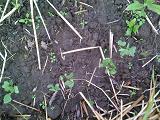 |
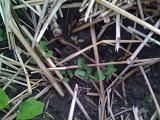 |
| Onions (Golden Onion of Parma) (Row 20): Cannot tell if any non-weeds are coming up. |
Honeydew Melon (Early Dew) Seedlings (Row 21-r): All eaten and dead |
Watermelon (Sugar Baby) Seedlings (Row 21-l): Not growing |
Pumpkin (Jack Be Little) Seedlings (Row 22-l): Not growing |
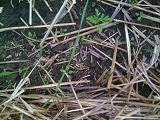 |
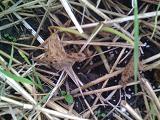 |
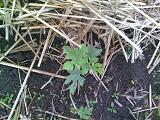 |
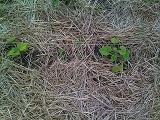 |
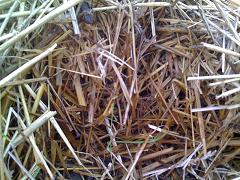 To the right is a picture under the straw. Look at how it's wet and gradually
breaking down. It's feeding the soil as I type this! In the Fall, I will collect leaves from
local trees and add them to the garden to feed the soil over the Winter.
To the right is a picture under the straw. Look at how it's wet and gradually
breaking down. It's feeding the soil as I type this! In the Fall, I will collect leaves from
local trees and add them to the garden to feed the soil over the Winter.





 I measured out 18 inches on each edge of the garden for walking (according to community garden rules)
and then staked out 24 rows (two feet apart) and put twine from the stakes across each row. Then it was
off to all of the gardening stores to look for organic seeds and seedlings. Almost everyone else had planted
weeks ago and at this point I had no plan as to what to plant. So, I just started buying whatever organic
seeds and seedlings I could find ... without any rhyme or reason. I kept telling myself and one fellow
gardener that "if I don't get the crops in the ground soon, the city won't have food for the Winter!"
I measured out 18 inches on each edge of the garden for walking (according to community garden rules)
and then staked out 24 rows (two feet apart) and put twine from the stakes across each row. Then it was
off to all of the gardening stores to look for organic seeds and seedlings. Almost everyone else had planted
weeks ago and at this point I had no plan as to what to plant. So, I just started buying whatever organic
seeds and seedlings I could find ... without any rhyme or reason. I kept telling myself and one fellow
gardener that "if I don't get the crops in the ground soon, the city won't have food for the Winter!" 23 out of 24 rows have been planted!!! Click on the Garden key to the right to see the crops
that have been planted.
23 out of 24 rows have been planted!!! Click on the Garden key to the right to see the crops
that have been planted.






 Are they weeds or something I've planted? I have no clue. To the right is a picture of a bunch of things
in Row 4: Carrots. I think the big thing in the center might be a carrot plant, but it may be a weed.
Ruth Stout suggested
few weeds will come up because of the hay/straw and to just throw some hay on top of the weeds that do
come up. But she's making the mistake that her readers (especially me!) know how to tell the difference
between a carrot and a weed!
Are they weeds or something I've planted? I have no clue. To the right is a picture of a bunch of things
in Row 4: Carrots. I think the big thing in the center might be a carrot plant, but it may be a weed.
Ruth Stout suggested
few weeds will come up because of the hay/straw and to just throw some hay on top of the weeds that do
come up. But she's making the mistake that her readers (especially me!) know how to tell the difference
between a carrot and a weed!
 In Row 3: Beets, I think the plant on the right with the purple-tinged leaves might be a beet? But
that big plant to the left looks eerily similar to what I thought was a carrot in the last picture.
Did the carrot wander over to Row 3? Clearly, the carrots, beets and weeds are all conspiring to confuse me!
In Row 3: Beets, I think the plant on the right with the purple-tinged leaves might be a beet? But
that big plant to the left looks eerily similar to what I thought was a carrot in the last picture.
Did the carrot wander over to Row 3? Clearly, the carrots, beets and weeds are all conspiring to confuse me!
 Ah, now this row is a breathe of fresh air. Those burgundy plants on the right side of Row 11 are almost
certainly the Amaranth (Burgundy) that I planted. My discovery: The key to gardening is to not grow any green
plants!
Ah, now this row is a breathe of fresh air. Those burgundy plants on the right side of Row 11 are almost
certainly the Amaranth (Burgundy) that I planted. My discovery: The key to gardening is to not grow any green
plants!
 These kale seelings are developing leaves with big white splotches on them. That's interesting!
Maybe the splotches will turn green as the kale matures.
These kale seelings are developing leaves with big white splotches on them. That's interesting!
Maybe the splotches will turn green as the kale matures.












 To the right is a picture under the straw. Look at how it's wet and gradually
breaking down. It's feeding the soil as I type this! In the Fall, I will collect leaves from
local trees and add them to the garden to feed the soil over the Winter.
To the right is a picture under the straw. Look at how it's wet and gradually
breaking down. It's feeding the soil as I type this! In the Fall, I will collect leaves from
local trees and add them to the garden to feed the soil over the Winter.